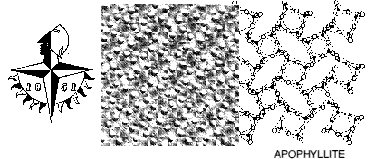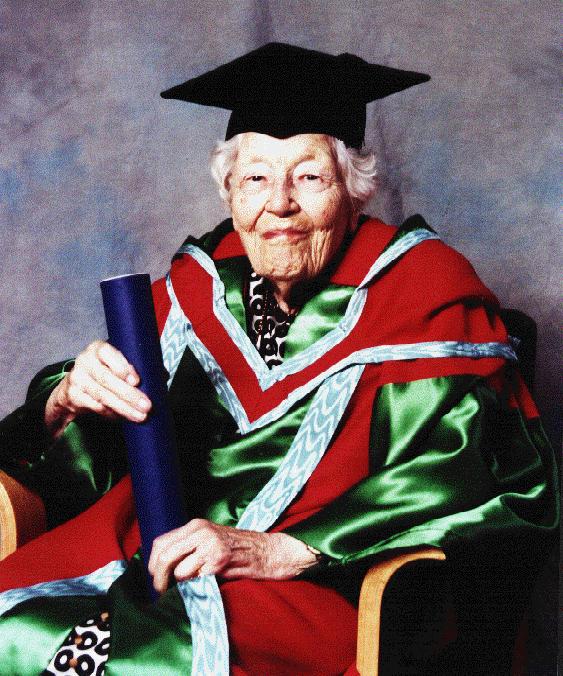
British CrystallographicAssociation
'Crystallography News'
December 2000
Honour for one of our oldest members
Editor's Note: At the BCA Annual meeting held in Leeds in 1997Mike Glazer organised members to sign a special birthday card sending ourgood wishes to Helen Megaw on the occasion of her 90th birthday later inthe year.
We now offer her our congratulations on receiving an honorary degreefrom Queen's University, Belfast, Northern Ireland on7 July 2000. I am grateful to Dr. E.V McKee of Loughborough Universitywho sent me the photograph and the copy of the Citation reproducedbelow.
Further information about Helen Megaw can be found in 'CrystallographyNews' for June 1997 page 16 and from the web pages on women crystallographers at URLhttp://www.physics.ucla.edu/~cwp. Durward Cruickshank visited the Antarcticin January 1998 and subsequently researched the article published in theMarch 99 issue pages 10-13 on the naming of features of Crystal Sound aftercrystallographers who worked on the structure of ice, including Megaw Island.
In 1951 Helen Megaw was a scientific consultant to the 'Festival PatternGroup' who promoted crystallographic patterns as a basis for householdtextiles, window glass and china as part of the 'Festival of Britain'.These are beautifully described in 'The Souvenir book of CRYSTAL DESIGNS,the fascinating story in colour of the FESTIVAL PATTERN GROUP', fromwhich the illustration below was taken.
 Figuredrolled glass made by Chance Bros. which was popular for many years. Thepattern is on a slant, and the repeat small; the blobs themselves are alsosmall so that sunshine does not burn any curtains behind the glass.
Figuredrolled glass made by Chance Bros. which was popular for many years. Thepattern is on a slant, and the repeat small; the blobs themselves are alsosmall so that sunshine does not burn any curtains behind the glass.
Samples of some of these textiles and ashtrays have been safely storedin the Science Museum, London where they were on display earlier this year.Many more were displayed in 1951 in the Regatta Restaurant, South Bank,London, including a fine tea set by R.H. and S.L. Plant Ltd, If anyoneknows the current whereabouts of samples of this tea set, please let meknow. Who knows? We may be able to inspire the designers of 2001 to emulatethose of 1951 and base their designs on crystallographic patterns.
Kate Crennell
Dr H Megaw: Citation for Honorary Degree of Doctor of Science
by Professor Ruth Lynden-Bell, School of Mathematics and Physics
Dr Helen Megaw is a crystallographer who is best known for her workdetermining the structure of ferroelectric crystals. She is a native ofNorthern Ireland who attended Queen's for a year before moving to get herdegrees of BA and PhD from the University of Cambridge. She returned toNorthern Ireland when she retired from the University of Cambridge in 1972.
It is difficult for us to imagine the scientific environment in thenineteen thirties. It was a time of depression with little money and fewjobs. Science departments were much smaller and more intimate. X-ray crystallographywas a new science which attracted a number of young women such as Dr Megawwho became distinguished scientists. In those pioneering days preparationof crystals and collection of data was more difficult and more skilledthan it is today. Another big difference, which today's graduates may findhard to imagine, was that there were no computers and the tedious and detailedcalculations which lead from the brightness of spots on a photographicplate to a three dimensional crystal structure were all done by hand. DrMegaw was one of the pioneers in this field. She completed her PhD on thestructure of ice in the early nineteen thirties. Then, after a couple ofyears' postdoctoral work in Vienna and Oxford, she spent seven years teachingin girls' schools in England and a year in an industrial research laboratory.After the second world war her career changed and she spent the rest ofher working life in Universities, mainly in the Cavendish Laboratory inCambridge. She became a Fellow of her old college, Girton, where she actedas Director of Studies in Physical Sciences encouraging and guiding generationsof young women scientists.
Her research work was concerned with ferroelectric crystals. You areall familiar with magnets which have two ends with opposite magnetic polarity.Ferroelectric crystals are the electric analogues with two ends with oppositeelectric polarity. As you can imagine they are important industrially.The source of the ferroelectricity lies in the arrangement of the atomsin the crystals and this was determined by Dr Megaw for an important classof ferroelectric crystals known as Perovskites. She then wrote a standardbook on "Ferroelectricity in Crystals".
She also did pioneering work on disorder in crystals and its effecton the X-ray diffraction patterns. She was awarded the Roebling Medal ofthe Mineralogical Society of America in 1989 and has an Island in the Antarcticnamed after her in recognition of her work on ice.

Dr Megaw, Queen's University wishes to recognise your contributionto science and the example that you have set to generations of young womenand young men. I now call upon the Dean of the Faculty of Engineering topresent Helen Megaw for the degree of Doctor of Science, honoris causa.